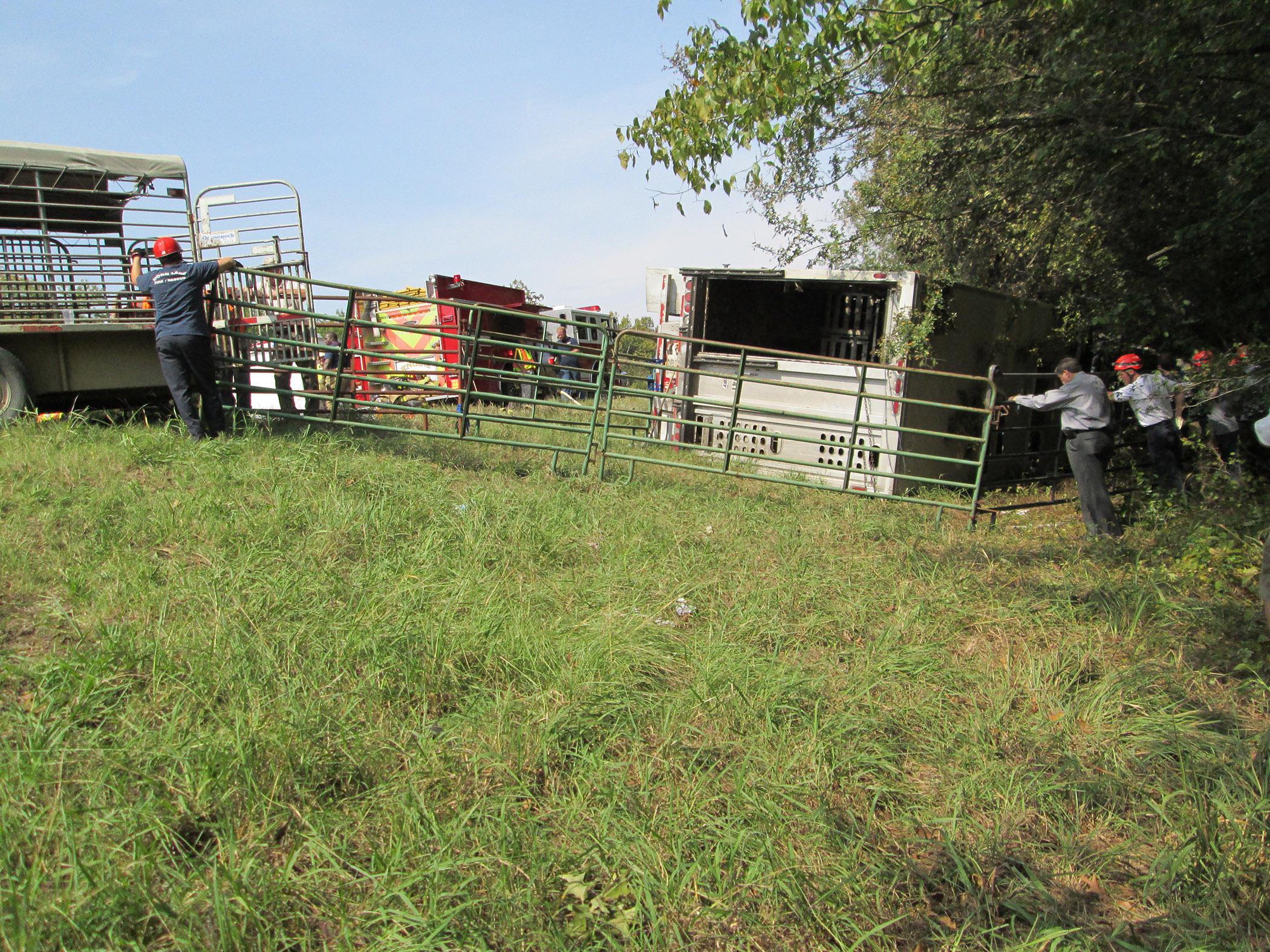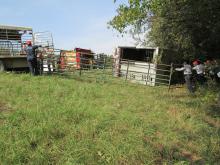Information Possibly Outdated
The information presented on this page was originally released on October 5, 2012. It may not be outdated, but please search our site for more current information. If you plan to quote or reference this information in a publication, please check with the Extension specialist or author before proceeding.
Livestock trailer accident interrupts training class
VERONA – DeSoto County emergency responders were just settling in for a day of large animal rescue training when the call came on Sept. 28.
“An 18-wheeler hauling about 100 calves through the state hit the Coldwater River bridge on Highway 78 in DeSoto County,” said Dr. Carla Huston, an associate professor with the Mississippi State University College of Veterinary Medicine and a member of the CVM Disaster Response Team. This was not a drill.
“This incident put our animal response plans to the test. We knew we would find out if those responding understood the Incident Command System, something the Extension Service and other agencies have been promoting across the state,” said Huston, who is also an Extension veterinarian. “They needed lots of help responding to this major accident.”
Jesse Carter, a field director with the Mississippi Board of Animal Health, was attending the Technical Large Animal Emergency Response class in Verona when he got the call for help. Instructors and facilitators joined in the call to form a plan of action before the DeSoto team left with Grenada veterinarian Dr. Tom Abernethy and one of the course instructors, Dr. Tomas Gimenez, an internationally recognized expert in large animal rescues.
“Dr. Abernethy is a member of the Veterinary Strike Team with the Mississippi Animal Response Team, which is the main reason we decided to send him. It helped that he is also in law enforcement,” Huston said. “I called upon another local veterinarian from Holly Springs, who showed up on scene to assist.”
Lance Newman, an Extension area livestock agent based in Lafayette County, was contacted by Extension’s disaster preparedness coordinator to bring hay and other items that might be needed to the scene.
“We tried to anticipate the needs for gathering up loose cattle. Often, when cattle are stressed like that, they won’t wander far. They just want to be left alone,” Newman said. “Several of the loose cows went into some nearby woods, and they had access to water there from a small creek.”
Newman said in addition to the emergency officials, workers from a local sale barn and others came to help.
“It helped that several of us had attended some of the large animal rescue classes in the past, and having Dr. Gimenez there was key in the recovery process,” Newman said. “He was trying to remove the survivors as quickly as possible and also considering the human element. You have to assess these situations for human safety. We wanted to help the animals as quickly as possible, but no animal is more important than a human.”
Tim Curtis, deputy director of the DeSoto County Emergency Services, said Gimenez was able to offer valuable advice for handling the calves and the trailer.
“We were not familiar with the psychology of cows. We had cattle farmers offering to help, but they did not have disaster experience,” Curtis said. “When cows are down after an accident, they don’t want to get up. Dr. Gimenez showed us how to raise them to their feet.”
Curtis said responders had not had experience with a double-decker livestock transporter.
“We weren’t familiar with the design of this cattle trailer. Dr. Gimenez was able to show us where we could and could not cut to remove the cows,” he said.
Curtis said of the 105 recently weaned calves on the trailer, 43 died at the scene. The experience confirmed his belief in the importance of the Incident Command System, or ICS.
“For example, when the Mississippi Board of Animal Health’s field director, Jesse Carter, arrived, he was briefed and immediately absorbed into our ICS structure as a technical specialist. He provided us with a tremendous amount of information and guidance,” he said.
“The Incident Command System allowed a wealth of knowledge from multiple agencies to come together,” Curtis said. “We had 14 separate agencies and numerous private resources come together and function as a team under the command structure. There were no turf battles, no disagreements or any of the problems that one would expect from an incident of this severity and magnitude.”
Curtis said anyone who might respond in an emergency or disaster situation should complete the ICS training ahead of time. MSU’s Extension Service provides basic, intermediate and advanced ICS training throughout Mississippi. For more information on ICS training, contact the Center for Governmental Training and Technology at (662) 325-3141 or ics@ext.msstate.edu.






